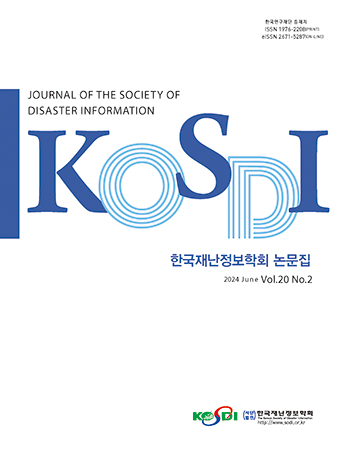Research Article
Abstract
References
Information
Purpose: The purpose of this study is to attain the correlation analysis and thereby to deduce the uniaxial compressive strength of rock specimens through the elastic wave velocity and the elastic modulus among the physical characteristics measured from the rock specimens collected during drilling investigations in Seoul and Gyeonggi region. Method: Experiments were conducted in the laboratory with 119 granite specimens in order to derive the correlation between the compressive strength of the rocks and elastic wave velocity and elastic modulus. Results: In the case of granite, the results of the analysis of the interaction between the compressive strength of a rock and the elastic wave velocity and elastic modulus were found to be less reliable in the relation equation as a whole. And it is believed that the estimation of the compressive strength by the elastic wave velocity and elastic modulus is less used because of the composition of non-homogeneous particles of granite. Conclusion: In this study, the analysis of correlation between the compressive strength of a rock and the elastic wave velocity and elastic modulus was performed with simple regression analysis and multiple regression analysis. The coefficient determination (R2) of simple regression analysis was shown between 0.61 and 0.67. Multiple regression analysis was 0.71. Thus, using multiple regression analysis when estimating compressive strength can increase the reliability of the correlation. Also, in the future, a variety of statistical analysis techniques such as recovery analysis, and artificial neural network analysis, and big data analysis can lead to more reliable results when estimating the compressive sterength of a rock based on the elastic wave velocity and elastic modulus.
연구목적: 본 연구에서는 서울‧경기지역의 화강암을 대상으로 시추조사 시 채취된 암석 시료에서 측정된 물리적 특성 중 탄성파속도와 탄성계수로부터 암석의 일축압축강도와의 상관성을 분석하여 암석의 일축압축강도를 추정하는 것을 목적으로 한다. 연구방법: 119개의 화강암 시추 코아 시료를 대상으로 탄성파 속도와 탄성계수 그리고 일축압축강도와의 상관관계를 도출하기 위하여 실내 암석 실험을 실시하였다. 연구결과: 화강암에 대하여 탄성파속도와 일축압축강도 그리고 탄성계수와의 상호 관계를 단순회귀와 다중회귀로 분석한 결과는 전반적으로 관계식에 나타난 것처럼 신뢰도가 낮음을 확인하였다. 이는 화강암의 구성 입자가 균질하지 못하여 탄성파속도와 탄성계수를 이용한 압축강도 추정에 대한 활용성이 낮은 원인으로 사료된다. 결론: 본 연구에서 암석의 탄성파속도와 탄성계수로부터 일축압축강도를 추정하기 위한 상관관계를 분석하기 위하여 단순회귀분석과 다중회귀분석 방법을 이용하였다. 단순회귀분석은 결정계수(R2)가 0.61~0.67 이었으며 , 다중회귀분석은 0.71로 나타났다. 따라서 다중회귀분석을 이용하여 암석의 일축압축강도를 추정할 때 다소 신뢰성이 높아질 수 있다. 또한, 향후 탄성파 속도와 탄성계수를 이용한 암석의 일축압축강도를 추정할 때 다양한 통계분석 기법(회귀분석, 인공신경망, 빅데이터 분석 등)을 활용하면 보다 신뢰성이 높은 결과를 얻을 수 있을 것으로 본다.
- ASTM (American Society for Testing Materials, D 2938-95) (2005). Standard Test Method for Unconfined Compressive Strength of Intact Rock Core Specimens, Designation : D2938-95, Annual Book of ASTM Standards.
- ASTM (American Society for Testing Materials) (2009). Standard Test Method for Compressive Strength and Elastic Modulus of Intact Rock Core Specimens under Varying States of Stress and Temperatures, Designation : D7012-07el, Annual Book of ASTM Standards.
- Baek, S.C., Kim, Y.T., Kim, H.T., Yoon, J.S., Lee, Y.G. (2006). “Evaluation of Rock Uniaxial Compressive Strength Using Ultrasonic Velocity.” Journal of the Korean Geo-Environmental Society, Vol. 7, No. 2, pp. 33-42.
- Broch, E., Franklin, J.A. (1972). “The point-load strength test.” International Journal of Rock Mechanics and Mining Sciences & Geomechanics Abstracts, Vol. 9, Is. 6, pp. 669-697. 10.1016/0148-9062(72)90030-7
- Choi, G.H., Baek, S.C. (2014). “Predicting the Uniaxial Compressive Strength and Young’s Modulus of Rocks using Ultrasonic Velocity.” Journal of the Korean Geo-Environmental Society, Vol. 15, No. 2, pp. 53-58. DOI: http://dx. doi.org/10.14481/jkges.2014.15.2.53. 10.14481/jkges.2014.15.2.53
- Civil Engineering-Related Terminology Committee (1997). A civil engineering term dictionary, Book pressure Tamguwon, Seoul, Korea.
- Inoue, M., Ohomi, M. (1981). Relation between uniaxial compressive strength and elastic wave velocity of soft rock. In: K. Akai, M. Mayashi, Y. Nishimatsu, Editors. Proceedings of the International Symposium on Weak Rock, Tokyo, pp. 9-13.
- ISRM (International Society for Rock Mechanics) (1981). Rock characterization, testing and monitoring-ISRM suggested methods. In: Brown, E.T.(Ed.), London: Pergamon Press, Oxford, p. 211.
- Jang, J.H. (2010). Evaluation of Rock Uniaxial Compression Strength by Elastic Wave Velocity. Master’s thesis, Andong University, Andong, Korea, pp. 1-69.
- Kahraman, S. (2001). “Evaluation of simple methods for assessing the uniaxial compressive strength of rock.” International Journal of Rock Mechanics and Mining Sciences, Vol. 38, No. 7, pp. 981-984. 10.1016/S1365-1609(01)00039-9
- Kim, B.K., Lee, B.K., Jang, S.J., Lee, S.G. (2018). “A Study on the Correlations between the Physical Characteristics of Rock Types by Multiple Regression Analysis and Artificial Neural Network.” The Journal of Engineering Geology, Vol. 28, No. 4, pp. 673-686. DOI: https://doi.org/10.9720/kseg.2018.4.673. 10.9720/kseg.2018.4.673.
- Korea Society for Rock Mechanics and Rock Engineering (2005). Standard test method for uniaxial compressive strength of rock. Tunnel & Underground Space, Vol. 15, No. 2, pp. 85-86.
- KS E 3033 (Korea Industrial Standards E) (2006). Korean Agency for Technology and Standards, Methods of test for compressive strength of rock.
- Lee, J.S., Moon, J.K., Choi, W.E. (2011). “Analysis of Correlation Between Velocity of Elastic Wave and Mechanical Properties of Rocks.” Journal of Korean Society for Rock Mechanics, TUNNEL & UNDERGROUND SPACE, Vol. 21, No. 1, pp. 50-65.
- Yasar, E., Erdogan, Y. (2004). “Correlating sound velocity with the density, compressive strength and young's modulus of carbonate rocks.” International Journal of Rock Mechanics and Mining Sciences, Vol. 41, No. 5, pp. 871-875. 10.1016/j.ijrmms.2004.01.012
- Publisher :The Korean Society of Disaster Information
- Publisher(Ko) :한국재난정보학회
- Journal Title :Journal of the Society of Disaster Information
- Journal Title(Ko) :한국재난정보학회논문집
- Volume : 15
- No :2
- Pages :249-258
- DOI :https://doi.org/10.15683/kosdi.2019.06.30.249




 Journal of the Society of Disaster Information
Journal of the Society of Disaster Information







